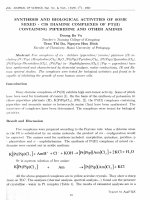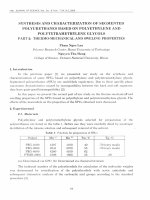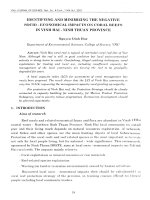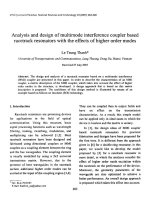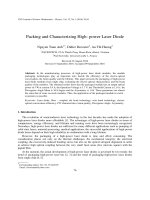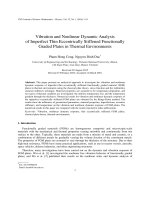DSpace at VNU: Multiguiders and nondominate ranking differential evolution algorithm for multiobjective global optimization of electromagnetic problems
Bạn đang xem bản rút gọn của tài liệu. Xem và tải ngay bản đầy đủ của tài liệu tại đây (460.48 KB, 4 trang )
IEEE TRANSACTIONS ON MAGNETICS, VOL. 49, NO. 5, MAY 2013
2105
Multiguiders and Nondominate Ranking Differential Evolution Algorithm
for Multiobjective Global Optimization of Electromagnetic Problems
Nyambayar Baatar , Minh-Trien Pham , and Chang-Seop Koh , Senior Member, IEEE
College of Electrical and Computer Engineering, Chungbuk National University, Cheongju, Chungbuk 361-763, Korea
University of Engineering and Technology, Vietnam National University, Hanoi 100000, Vietnam
The differential evolution (DE) algorithm was initially developed for single-objective problems and was shown to be a fast, simple
algorithm. In order to utilize these advantages in real-world problems it was adapted for multiobjective global optimization (MOGO)
recently. In general multiobjective differential evolutionary algorithm, only use conventional DE strategies, and, in order to optimize
performance constrains problems, the feasibility of the solutions was considered only at selection step. This paper presents a new multiobjective evolutionary algorithm based on differential evolution. In the mutation step, the proposed method which applied multiguiders
instead of conventional base vector selection method is used. Therefore, feasibility of multiguiders, involving constraint optimization
problems, is also considered. Furthermore, the approach also incorporates nondominated sorting method and secondary population for
the nondominated solutions. The propose algorithm is compared with resent approaches of multiobjective optimizers in solving multiobjective version of Testing Electromagnetic Analysis Methods (TEAM) problem 22.
Index Terms—Differential evolution, multiguiders, multiobjective optimization, nondominated ranking, Testing Electromagnetic
Analysis Methods (TEAM) problem 22.
I. INTRODUCTION
I
N ENGINEERING application, optimization problems involving multiple objectives together with constraints are
popular. Therefore, many multiobjective global optimization
(MOGO) algorithms have been proposed. In order to apply the
DE algorithm for solving MOGO problems, the original scheme
has to be modified since the multiobjective problems do not
consist of single solution. Instead, in multiobjective optimization, a set of different solutions should be founded and called
Pareto-optimal front. There are two issues when designing a
multiobjective evolutionary algorithm: population diversity and
survivor selection. The first issue is directly related to the question of how to guide the search towards the Pareto-optimal front
[1]. The second one addresses the question of which individual
will be kept during the evolution process.
In the past, a wide variety of evolutionary algorithms (EAs)
have been used to solve multiobjective optimization problems
[2]. However, from the several types of EAs available, few researchers have attempted to extend DE [3] to solve multiobjective optimization problems. DE has been very successful in the
solution of a variety of continuous (single-objective) optimization problems in which it has shown a great robustness and a
very fast convergence. These are precisely the characteristics
of DE that make it attractive to extend to solve multiobjective
optimization problems. DE has been adapted to solve MOGO
in several ways. In the early approaches (PDE [4] and GDE
[5]), only the concept of Pareto dominance was used to compare the individuals. The candidate replaced its parent only if
it (weakly) dominated it. Otherwise, it was discarded. This is
a rather strict demand, especially when the number of objectives is high. Many subsequent approaches (PDEA [6], MODE
[7], and NSDE-DCS [8]) used nondominated sorting and/or the
crowding distance metric to calculate the fitness of individuals.
Therefore we proposed multiguiders nondominated ranking
differential evolution algorithm (MG-NRDE) for solving
MOGO problems.
In mutation step, the proposed method introduces new base
vector selection method for constrained multiobjective optimization by adopting multiguiders. Additionally, the approach
also incorporates nondominated sorting method [9] and secondary population for the nondominated solutions to archive
Pareto front solutions. The proposed algorithm is compared
with recent approaches of multiobjective optimizers in solving
multiobjective version of TEAM problem 22.
The remainder of this paper is organized as follows. Section II
provides fundamentals of the MOGO problems and DE algorithm. In Section III we described the proposed multiguiders
nondominated ranking DE in detail. TEAM problem 22 and
comparison results are provided in Section IV. Finally Section V
contains our conclusions.
II. FUNDAMENTALS OF MOGO PROBLEMS AND DE
Some fundamentals and basic definitions related to this work
are introduced in following subsections.
A. MOGO Problems
A general MOGO problem contains a number of conflicting
objectives, for example, to be minimized and optional constraints to be satisfied. Mathematically, a MOGO problem is
formulated as follows:
Minimize
subject to
(1)
Manuscript received November 21, 2012; revised December 26, 2012; accepted January 08, 2013. Date of current version May 07, 2013. Corresponding
author: C.-S. Koh (e-mail: ).
Color versions of one or more of the figures in this paper are available online
at .
Digital Object Identifier 10.1109/TMAG.2013.2240285
and
are the
where is the vector of design variables,
numbers of the objectives and constraints, respectively.
In practical applications, there is no solution that can miniobjectives simultaneously. As a result, mulmize all of the
0018-9464/$31.00 © 2013 IEEE
2106
IEEE TRANSACTIONS ON MAGNETICS, VOL. 49, NO. 5, MAY 2013
tiobjective optimization problems tend to be characterized by a
family of alternatives that must be considered equivalent in the
absence of information concerning the relevance of each objective relative to the others [1]. These alternatives are referred to
as Pareto optimal solutions.
A multiobjective optimization problem, on the other hand,
has a set of optimal solutions which every member is not dominated by others. All the members are optimal from the viewpoint
of one (or more) objective(s), but none of them is optimal for all
the objectives. The choice among the Pareto-optimal solutions
belongs to a designer’s decision [1], [9].
The target of a MOGO algorithm, therefore, is to converge to
the true Pareto-front and to provide a good distribution of the
solutions on the entire Pareto-front.
B. Deferential Evolution Algorithm
The differential evolution algorithm is a novel parallel direct
search method, which utilizes
parameter vectors as a population
, for each generation .
The crucial idea behind DE is a scheme for generating trial
parameter vectors. DE generates new parameter vectors by
adding a weighted difference vector between two population members to a third member. Currently, there are several
variants of DE. The particular variant described throughout
this section is the “DE/rand/1/bin” scheme. Each individual
) is a -dimensional vector
with parameter values determined randomly and uniformly in
the search space
(2)
For each target vector
a mutant vector
) is generated by mutation operator. where
, and
are randomly chosen indexes.
Note that indexes have to be different from each other,
is
, and are difference vector
called base vector index, and
indexes.
After mutation, the binominal crossover is applied to generate
the trial vector. The specified process is shown in (3)
if
otherwise
In order to provide good Pareto front, the suggested algorithm
incorporates nondominated ranking and multiguiders methods.
The proposed multiguiders nondominated ranking DE (MGNRDE) algorithm keeps two populations: the main population
which is the target population (used to search Pareto optimum
solutions) and external population (to archive nondominated
solutions and provide guiders).
Additionally, in mutation step, we considered feasibility of
solution when we select the guiders; this action will be taking
into account in case of performance constraint problems.
Furthermore, when number of external solutions exceeds its
maximum value, an improved pruning method [10] is used to
remove the solutions with small crowding distance, one by one
until number of solutions equals to its maximum value.
Step 1: Initialize the target population.
• Generate
target population with randomly uniform,
.
and set the iteration counter
• Evaluate all objective function and constraint values,
and apply nondominated sorting to rank the all individuals in the current population, and calculate crowding
distance in each rank.
• Store nondominated solutions into the external archive
, Calculate the crowding distance in objective space
(objective crowding distance) for all members in .
Step 2: Generate mutant populations
.
• Randomly select the first guider (in conventional DE
would be called base vector) from the top 10% of
solution with the big crowding distances.
• Second guider
required only when the fist guider is
not extreme solution [1].
• Between the two nondominated solutions beside
in
Pareto-front, as shown in Fig. 1, the one with bigger
crowding distance is selected as the second guider. And
the feasibility of the guiders must be considered. And
then
generated by using (5)
or
(5)
(3)
where a trial vector
is generated from the mutant vector
and its target vector
based on probabilistic parameter
selection. Cr is a user-specified crossover factor in the range
[0,1) and
is a randomly chosen integer in the range [1,
] to ensure that the trial vector
will differ from its correby at least one parameter
sponding target vector
if
else
III. PROPOSED MULTIGUIDERS NONDOMINATED
RANKING DE ALGORITHM
(4)
The fitness value of each trial vector
is compared
to that of its corresponding target vector
in the current
population, and one with better fitness will be selected for next
iteration. The selection operation is expressed in (4).
is -th mutant vector.
and
are guiders.
and
are randomly selected difference
is number of population.
are
vector.
random numbers in [0, 1]; however,
is the uniform
distribution and
is Gaussian distribution.
,
is an extreme solution.
when the
Step 3: Crossover operation.
• Generate trial vector
using binominal crossover expressed in (3).
Step 4: Selection operator.
• Combine target population
and trial population
into 2
population.
• Update the number of feasible solutions .
— If
: And apply nondominated ranking
number
method for all feasible solutions to select
of individuals for the next iteration.
where
BAATAR et al.: MULTIGUIDERS AND NONDOMINATE RANKING DEA FOR MOGO OF ELECTROMAGNETIC PROBLEMS
2107
Fig. 1. Selection of two guiders and population ranking.
Fig. 2. SMES Configuration and Design variables.
— If
: the combination of feasible solutions
and
solutions with lowest sum of constraint
violation solutions will be selected the next iteration.
— In case of unconstrained problem: From the combined 2
population,
individuals with lower
rank will be will be survived for the next iteration.
— Note that Rank1 solutions in the Fig. 1 are the Pareto
front solutions in the current iteration.
— If the number of solutions in the Rank1 is greater than
, we apply improved pruning method to remove
the solutions with small crowding distance [10].
Step 5: Update nondominated solutions.
• External archive absorbs superior current nondominated solutions and eliminates inferior ones using constrained domination.
• If the number of solutions in A is bigger than predetermined value, reduce it by repeating following process:
— calculate the crowding distance for all members in ;
— remove the nondominated solutions which have small
crowding distance by using pruning method [3].
Step 6: Termination check.
• If termination condition (maximum number of iteration)
is not satisfied, go to Step 2, otherwise terminate.
IV. OPTIMIZATION RESULT
In order to validate the proposed algorithm, we adopted
three parameter version of multiobjective TEAM problem 22
reported in [11]. The TEAM problem 22 is an optimal design
of a superconducting magnetic energy storage device (SMES).
(SMES) configuration shall be optimized with respect to the
following objectives.
• The stored energy in the device should be 180 MJ.
• The magnetic field must not violate a certain physical condition which guarantees superconductivity
• The stray field (measured at a distance of 10 meters from
the device) should be as small as possible.
Multiobjective TEAM problem 22 is expressed in (6)
Minimize
subject to
(6)
Fig. 3. Critical curve of the superconductor. The true critical curve is in continuous black. The dotted line represents the linear approximation to the previous
curve used as quench condition limit in this paper.
TABLE I
VARIABLE RANGES AND VALUES USED
where the reference stored energy is
MJ and
are current density and magnetic flux density in the -th coil.
TEAM problem 22 is composed of two coils with opposite current densities. The first coil is charged to store the energy and
the second should be designed to diminish the high magnetic
stray caused by the first coil. The classical configuration of the
SMES device can be obtained from Fig. 2.
The superconducting material should not violate the quench
condition that links together the value of the current density and
the maximum value of magnetic flux density, as shown in Fig. 3.
The critical curve has been approximated by constraints in (6).
The range of the three design variables which defines the size
and position of the outer coil of the device and other fixed parameters are shown in Table I.
Optimal result of proposed algorithm is compared with those
from MultiGuiders Cross-search MOPSO [1] and Gaussian
MOPSO [12]. The optimization parameters are set exactly
same as in [1] for all algorithms, i.e., 30 individuals, maximum
number of iteration 200, and external archive of 100.
2108
IEEE TRANSACTIONS ON MAGNETICS, VOL. 49, NO. 5, MAY 2013
V. CONCLUSION
Fig. 4. Pareto-front obtained by MGC-MOPSO, G-MOPSO, and MG-NRDE.
TABLE II
COMPARISONS OF EXTREME SOLUTIONS
In this paper, the multiguiders nondominated ranking differential evolution algorithm (MG-NRDE) is developed for multiobjective optimization problems. The proposed algorithm is
compared with recent approaches of multiobjective optimizers
in solving multiobjective version of TEAM problem 22. Our
proposed approach was able to produce results that competitive with respect to other approaches such us MGC-MOPSO
and G-MOPSO. The comparison results show the advantageous
behavior of the proposed algorithm in locating Pareto optimal
solutions regarding the multiple objectives without missing the
extreme solutions. Furthermore, a better uniformly distribution
of solutions was obtained by the proposed algorithm.
ACKNOWLEDGMENT
This work was supported by the Basic Science Research Program through the NRF of Korea funded by the Ministry of Education, Science, and Technology (2011-0013845).
TABLE III
COMPARISONS OF SPACING METRIC USING CROWDING DISTANCE
Fig. 4 shows the obtained Pareto front solutions of
G-MOPSO, MGC-MOPSO and MG-NRDE respectively.
In order to show the difference more clearly, every four others
of Pareto front solution is shown in the figures. The solutions
obtained by MG-NRDE are more uniform distribution than
those of MGC-MOPSO and G-MOPSO. Furthermore, it is also
proven in comparison of spacing metric by using crowding
distances of Pareto front solutions.
Graphically we can see the proposed MG-NRDE obtained
better uniformly distributed Pareto front solutions while
G-MOPSO and MGC-MOPSO obtained Pareto fronts with
some crowding and discontinuity. But we can see the lower part
of Pareto front obtained by proposed method is not showing
the good results than other methods except the extreme solution. However, the proposed MG-NRDE algorithm shows
better result in the middle and upper part of the Pareto front.
Numerically, we compared the extreme solutions in Table II.
Comparison of space metric using crowding distance is shown
in the Table III. It is revealed that Pareto front obtained by
MG-NRDE has better distribution than these who obtained
by G-MOPSO and MGC-MOPSO. Additionally, the proposed
MG-NRDE has smaller standard deviation in the Pareto front. It
can be said that the proposed algorithm can find better solutions
regarding the multiple objectives.
REFERENCES
[1] M. T. Pham, D. Zhang, and C. S. Koh, “Multi-guider and
cross-searching approach in multiobjective particle swarm optimization for electromagnetic problems,” IEEE Trans. Magn., vol. 48,
no. 2, pp. 539–542, Feb. 2012.
[2] C. A. C. Coello, D. A. Veldhuizen, and G. B. Lamont, Evolutionary Algorithms for Solving Multi-Objective Problems. Norwell, MA, USA:
Kluwer, 2002.
[3] R. Storn and K. Price, “Differential evolution—A simple and efficient
adaptative scheme for global optimization over continuous spaces,” Int.
Comput. Sci., Berkeley, CA, USA, Tech. Rep. TR-95-012, 1995.
[4] H. A. Abbass, R. Sarker, and C. Newton, “PDE: A Pareto-frontier
differential evolution approach for multiobjective optimization problems,” in Proc. Congr. Evol. Comput., 2001, vol. 2, pp. 971–978.
[5] J. Lampinen et al., “DE’s selection rule for multiobjective optimization,” Dept. Inf. Technol., Lappeenranta Univ. Technol., Lappeenranta,
Finland, Tech. Rep., 2001.
[6] N. K. Madavan et al., “Multiobjective optimization using a Pareto differential evolution approach,” in Proc. Congr. Evol. Comput. (CEC),
May 2002, vol. 2, pp. 1145–1150.
[7] F. Xue, A. C. Sanderson, and R. J. Graves, “Pareto-based multiobjective differential evolution,” in Proc., Congr. Evol. Comput. (CEC),
Dec. 2003, vol. 2, pp. 862–869.
[8] A. W. Iorio and X. Li, “Incorporating directional information within
a differential evolution algorithm for multiobjective optimization,” in
Proc. Genetic Evol. Comput. Conf. (GECCO), Jul. 2006, vol. 1, pp.
675–682.
[9] K. Deb et al., “A fast and elitist multiobjective genetic algorithms:
NSGA-II,” IEEE Trans. Evol. Comput., vol. 6, no. 2, pp. 182–197, Apr.
2002.
[10] S. Kukkonen and K. Deb, “Improved pruning of nondominated solutions based on crowding distance for biobjective optimization problems,” in Proc. IEEE Congr. Evol., Comp., 2006, pp. 1179–1186.
[11] P. Alotto et al., “SMES optimization benchmark extended—Introducing uncertainties and pareto optimal solutions into TEAM22,”
IEEE Trans. Magn., vol. 44, no. 6, pp. 106–109, Jun. 2008.
[12] L. S. Coelho, H. V. Ayala, and P. Alotto, “A multiobjective Gaussian
particle swarm approach applied to electromagnetic optimization,”
IEEE Trans. Magn., vol. 46, no. 8, pp. 3289–3292, Aug. 2010.




